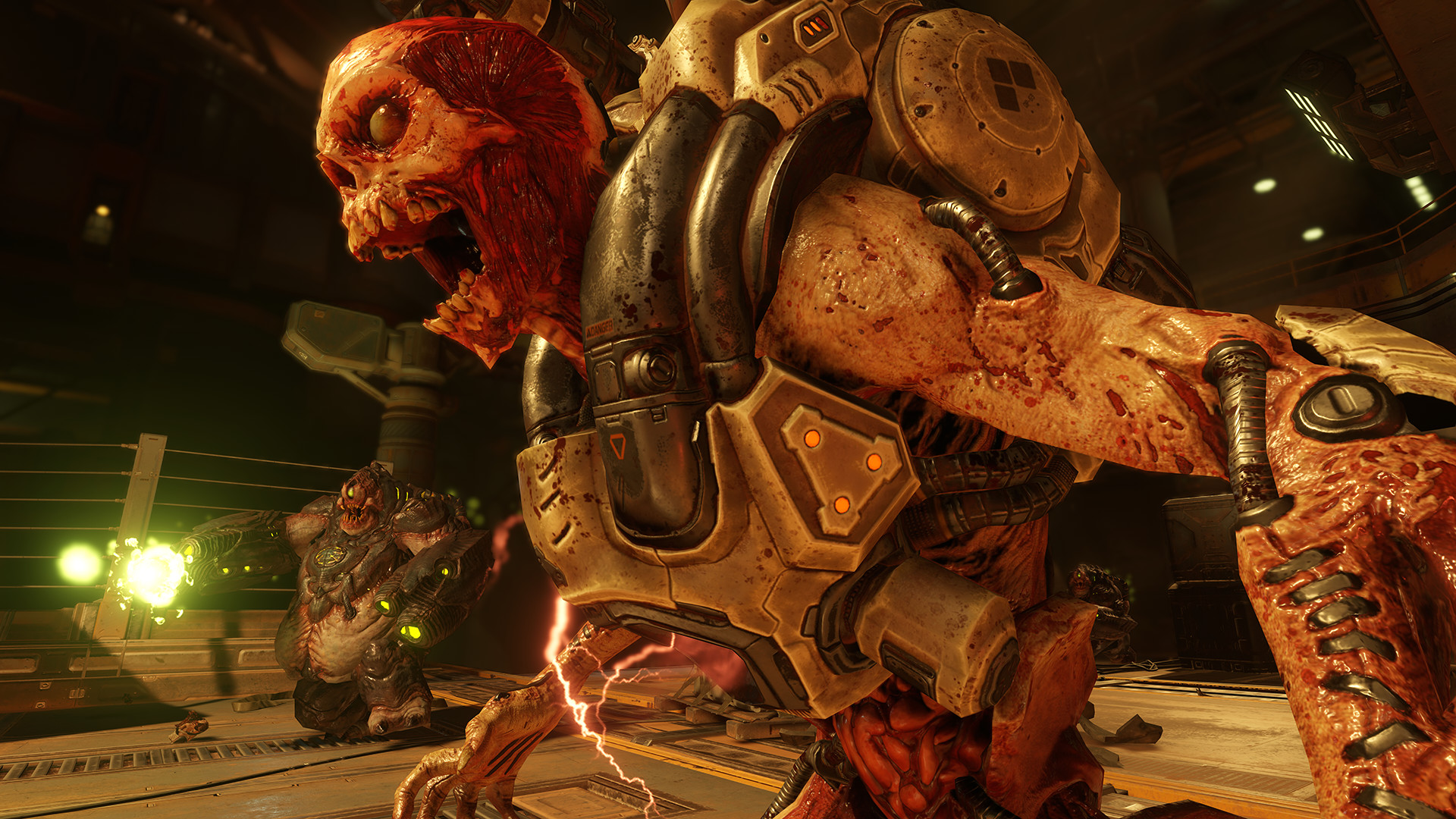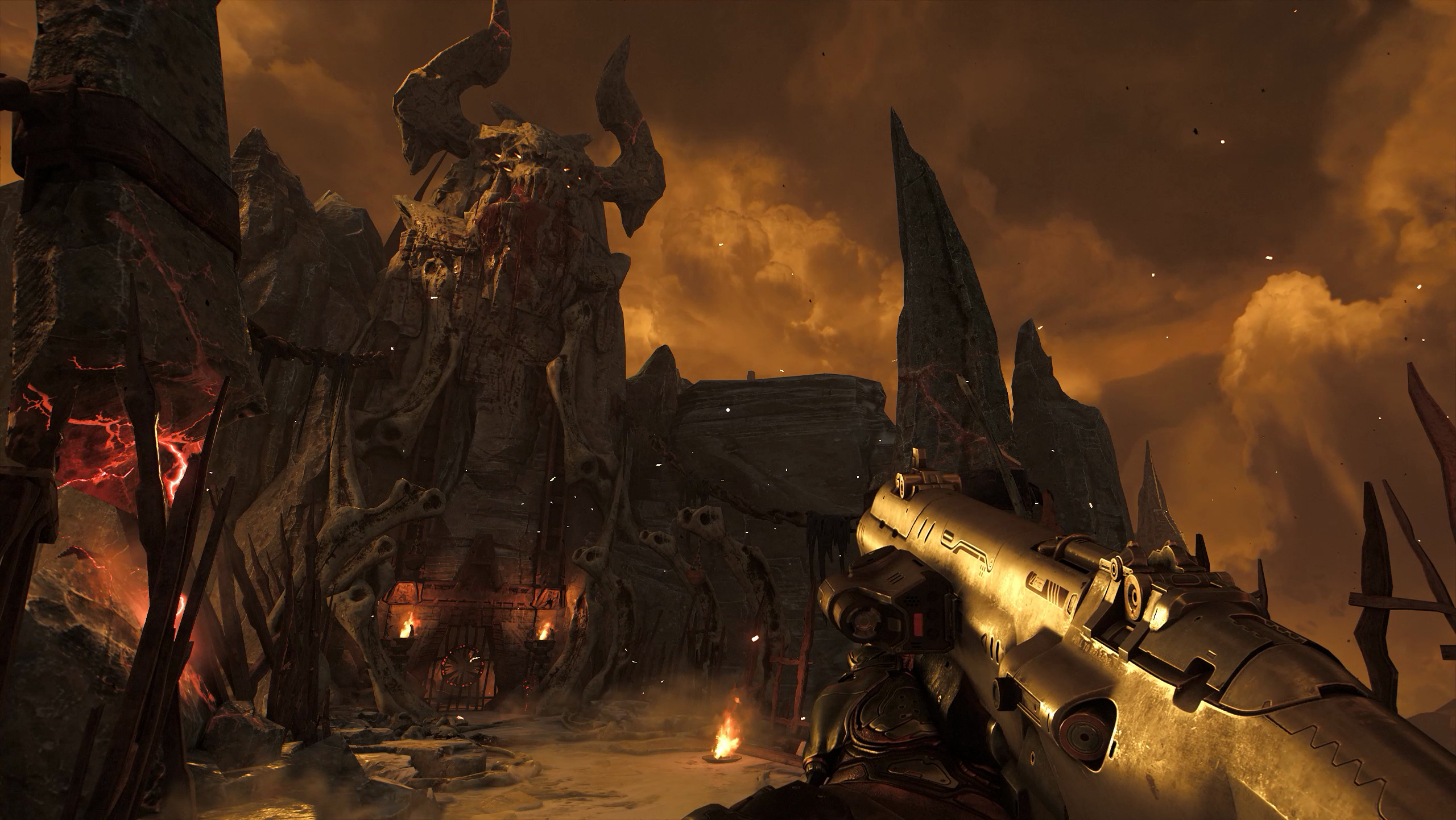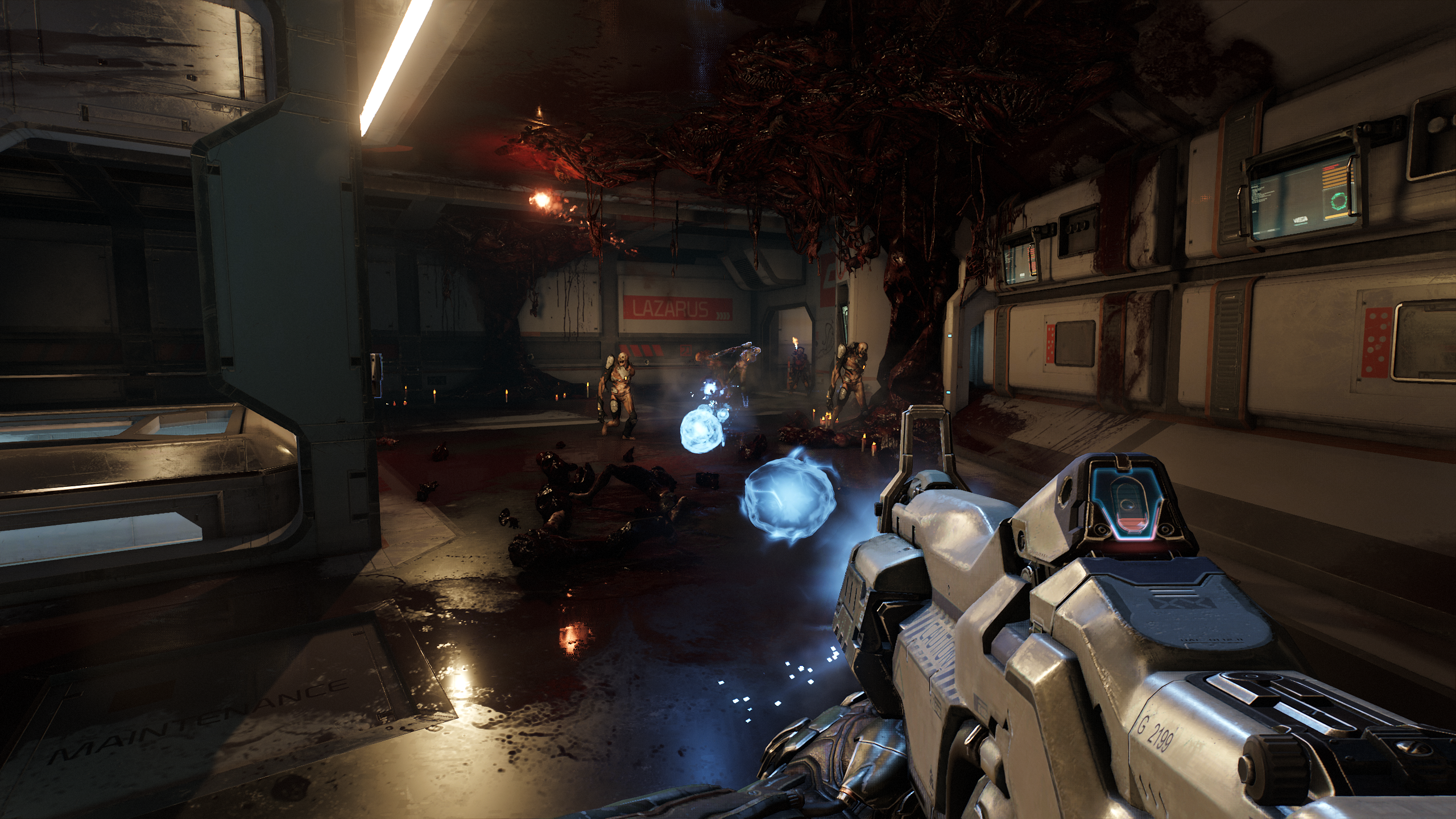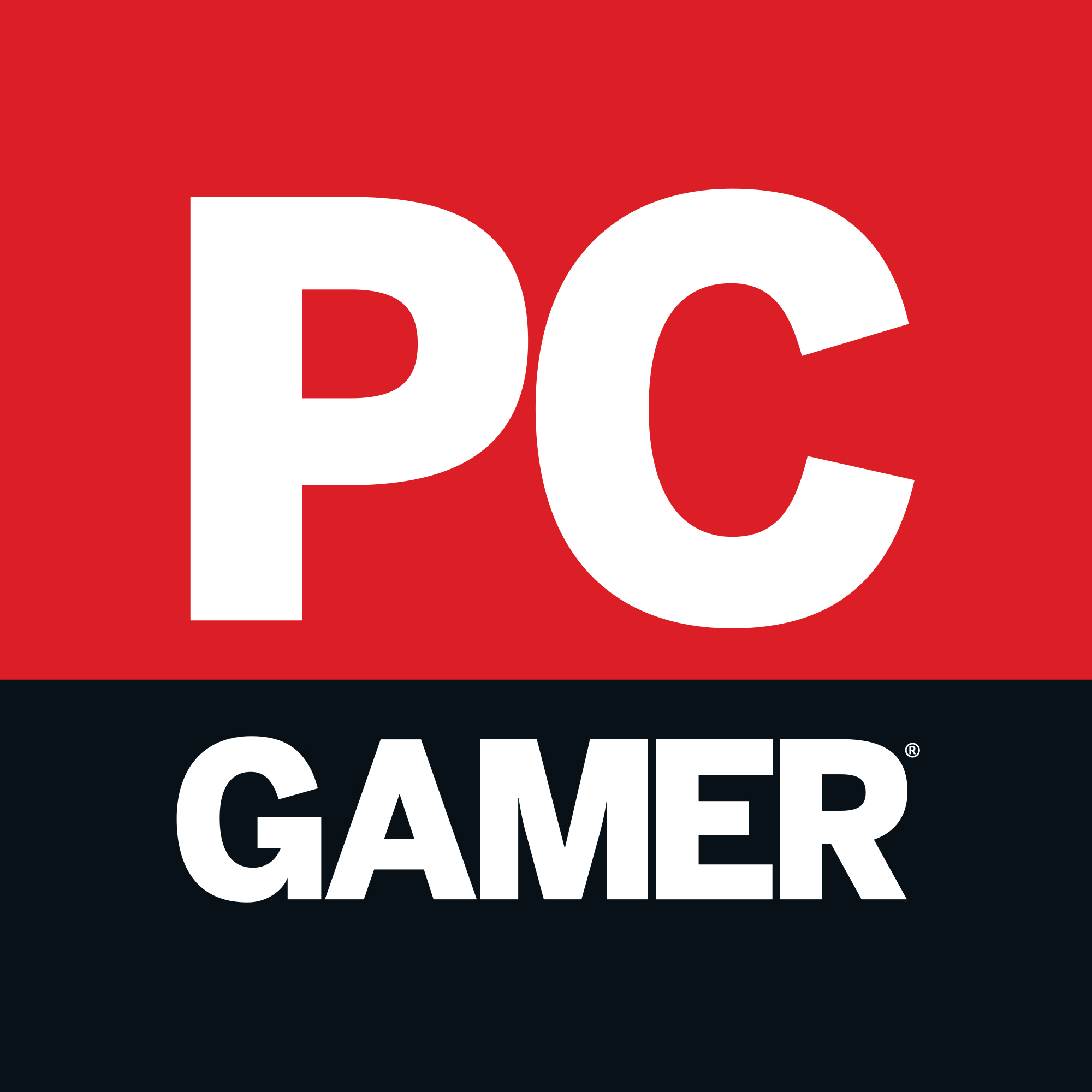
There aren’t many in the PC Gamer offices who aren’t playing Doom. As James explains in our review, its campaign is a masterwork of FPS design, so sharply designed it doesn't matter much that we don't collectively love the multiplayer—that's just a bonus layer on a brilliant mesh of classic and contemporary single-player shooting. We like Doom's campaign so much that we couldn’t leave our adoration at a single take—below you'll find a few more reasons the PCG staff is loving hell this week. Stay toasty.
Andy Kelly
The Doom Marine might look like a load of sentient ham shoved into a spacesuit, but he moves like a gun-toting ballet dancer of death. I was expecting Doom to be an FPS of the heavy, lumbering variety, but it’s the most blisteringly fast shooter I’ve played in years. You almost feel like you’re dancing around the level, pirouetting gracefully between demons, unloading your shotgun, tactically triggering glory kills to keep your health topped up.
When I first saw footage of these elaborate executions I thought it looked like a gimmick I’d get bored of in minutes, but the animation is so satisfyingly crunchy, and it’s over so quickly, that I’ve yet to get bored of them. And I like that it’s not just for show. When you’re inches from death and you score a glory kill, making the enemy spew a fountain of life-saving health packs, it’s proper knife-edge stuff.

You couldn’t really ask for a better Doom reboot.
One fight in particular in the foundry stuck with me. It takes place on a web of precarious, narrow walkways above a sea of molten metal. Hell Knights are constantly charging you, and there are breaks in the railings leading to a fiery death. So not only do you have to backpedal to fight off the Hell Knights, who can soak up a ridiculous amount of bullets, but you have to be constantly aware of your surroundings so you don’t fall off. It’s a brilliantly designed set-piece.
I’m not far into the campaign, though. That’s because I can only play for about an hour at a time. There’s something about the frenetic pace and the repetition that tires my brain out, and when I hit sixty minutes I start to feel demon fatigue. But that’s fine. It’s a game that’s perfectly suited to a quick hour-long blast. I even like the ‘modern’ upgrade stuff they’ve added to the weapons, particularly the combat shotgun’s explosive rounds. You couldn’t really ask for a better Doom reboot.
Tom Senior
I'm so used to moving at ordinary human speeds in shooters that Doom's pace comes as a surprise, even though it's a throwback to the great FPS games of yore.
Andy describes Doom combat as a dance, but for me it's a race. Doom's exceptional shotgun demands close proximity to be truly effective (though its effective range is surprisingly generous). When fireball-tossing imps jump up to a better position—dangling off pillars and flinging bolts from crates—I dash toward them, jump, and try to blow their heads into chunks with a single shot. For larger enemies I can take bloody lumps out of their torso and strafe around them faster than they can respond. In Doom, you don’t need powerups to feel godlike, you’re a terrifying green demon-killing machine from the outset.
Keep up to date with the most important stories and the best deals, as picked by the PC Gamer team.

Does it make sense that enemies explode in a gratifying shower of golden ammo when you saw a demon in half? Who cares?
The Doom Marine’s jump height, jump distance, mantling ability are all calibrated beautifully. Traversal is effortless. It feels amazing to roam back and forth through the campaign’s tiered arenas, hopping up a level to crush a sniper, then dropping down again to melee a grunt. I’m not normally a stickler for framerates, but Doom benefits from the responsiveness that a high FPS count provides.
It’s cleverer than it needs to be. After watching the debut E3 trailer, you’d be forgiven for thinking that the chainsaw is purely an indiscriminate close-combat massacre device, but it’s really a tactical ammo generator. Does it make sense that enemies explode in a gratifying shower of golden ammo when you saw a demon in half? Who cares? Instead the chainsaw becomes part of Doom’s smart see-sawing rhythm of resource expenditure and recuperation. Enemies leak more health vials if you’re low on health, or if you score a melee glory kill. With enough skill, there’s always a way to rescue yourself. Sometimes that means ripping a demon’s skull off its shoulders for a health boost. Sometimes that means chainsawing a thing in half to bring the shotgun back into play. Either way, it’s deeply satisfying, and the best shooter campaign I’ve played in years.
James Davenport
I went into Doom fully expecting the soundtrack to be a kitschy collection of ironic midi inspired quasi-metal guitar riffs and easy callbacks. Sure, the music is instantly recognizable, but in the same way the Doom interprets 1993’s acrobatic first-person shooting, the music pays homage while establishing a unique identity, and injects the combat with a healthy dose of energy and flow.
The music feels like a combination of Meshuggah and Animals as Leaders, maybe Gojira, with the 80s synth urgency of John Carpenter. Case in point, listen to this extract from Doom’s OST.
Heavy rhythmic riffs and double pedals that doesn’t quit—at least until the song cracks open and the synth pours out. Most of Doom’s combat music isn’t absolutely relentless, punctuated by quieter moody moments meant to grant a bit of breathing room and layer on atmosphere for the metal album cover environments.
Doom’s heavy tunes kick in like abstract commentary for the on-screen action.
During combat encounters, Doom’s heavy tunes kick in like abstract commentary for the on-screen action. As I dance (or race) around the arena, I learn to pay attention to the music and line up my actions with the rhythm. Imps are so numerous that I can almost treat them like a metronome, jumping on the offbeat and popping demons with the Super Shotgun on the downbeat. Were anyone to see me play Doom, they’d call out my subtle head-banging for sure.
The music’s first priority, like the whole of Doom, is to be fucking rad and reverent for the loud, aggressive, primal inspiration that metal is capable of tapping into. In that regard it succeeds, but only because it’s composed with the knowledge that as inspiring and ‘rad’ as the music can be, it’s pretty damn cheesy. And cheese isn’t a dealbreaker. Hell, Doom is brimming with the stuff. Through an unironic, controlled embrace of that cheese, Doom’s music (and everything else) pokes at some earnest ideas. The way I see it, by headbanging along to that double pedal and sending out a celebratory curse to the sky every time I disembowel a Cacodemon, I’m not celebrating violence, I’m celebrating play.
Chris Thursten
The thing I love about Doom isn’t just that it successfully revives an experience from the nineties—it’s that it modernises it. It’s retro in the way that a great modern arcade game like Geometry Wars is retro: it might look old-fashioned in some ways, but what it achieves could only be achieved with modern technology and a modern design sensibility. As such, Doom’s brilliant, frantic combat system has loads to teach contemporary shooters.
Case in point: health regeneration. There are loads of ways to handle this in a singleplayer shooter, and whichever method you choose has a major bearing on the type of experience you’ll end up with. Regenerating health bars encourage a cautious, cover-based approach. Healthpacks encourage resource management and map awareness alongside shooting skill. I get the sense that both of these approaches were deemed too slow, too passive for Doom.

Doom’s brilliant, frantic combat system has loads to teach contemporary shooters.
Doom is not a game about taking cover, backpedalling, running away, or anything other than starting a huge fight and seeing where it takes you. The fact that most of your health and ammo comes from melee-range takedowns—either with your fists or with the chainsaw—means that the right solution to a risky situation is almost always to punch your way through it.
You rarely feel like you’re getting screwed over in combat encounters, because as long as you keep fighting—and as long as you don’t make any stupid mistakes—the amount of health you get back from a glory kill is worth taking risks for. On the other hand, enemies feel threatening right up until the point when you subdue them. The game manages the tension between your power and theirs brilliantly: the moment when the odds tip in your favour (usually just as you’re beating a demon to death with one of its own limbs) is nu-Doom’s party trick, one that it rolls out in every single fight without exhausting its value.
The collective PC Gamer editorial team worked together to write this article. PC Gamer is the global authority on PC games—starting in 1993 with the magazine, and then in 2010 with this website you're currently reading. We have writers across the US, UK and Australia, who you can read about here.


